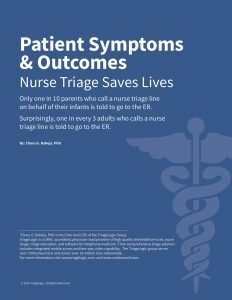By Dr. Ravi Raheja, TriageLogic’s Medical Director and CIO:
When a patient has a symptom, determining the appropriate triage level quickly and effectively
is critical for several reasons.
First, let us clarify what is a triage level?
A triage level is the appropriate level of care based on the patient’s symptoms and medical
history. Levels usually include dispositions such as call 911, go to the emergency room, urgent
care visit, primary care or telemedicine visit within 24 to 48 hours, or most commonly home
care.
Why is it important to get to the proper triage level as quickly as possible?
Patient safety
When a patient has a symptom, it may be difficult for them to determine on their own how
dangerous it is. For example, a headache could be a life-threatening stroke or a simple tension
headache. As people, we tend to ignore symptoms because we are busy or do not have easy
access to a healthcare professional. Ignoring signs can lead to a significant delay in care for
severe conditions and worsen the outcomes. As an example, in the case of a stroke, every
minute lost leads to adverse consequences that may impact the patient for the rest of their life.
Patient peace of mind
A patient may have a symptom they are concerned about but may be on the fence about
getting care based on the time of the day, other commitments, or the potential cost of seeking
care. A triage nurse will review the callers’ symptoms, medical history, and concerns. He/she will
further assist the patient in coming up with a plan of care that is reassuring and provides an
independent opinion. A triage nurse is crucial when the caller is trying to decide for a sick child
or a loved one and does not want to overreact. At the same time, the caller does not want to
miss a vital illness that could cause harm. A triage nurse is specially trained and uses Schmitt-
Thompson protocols along with their nursing training and judgment to assist in deciding for the
appropriate triage level.
Cost-effective care
In a health care environment where many patients have high deductibles, self-funded
companies, and shred risk by health care providers – cost-effective care is more critical than
ever. Using the appropriate level of triage care is essential to accomplish that since an
unneeded ER visit can cost over $2,000. And on the flip side, not being seen and having an
adverse outcome can lead to decreased quality of life and cost the health care system 100s of
thousands of dollars in medical care. A triage nurse can determine the appropriate triage level
of care to prevent any unnecessary cost for the patient.
Having a nurse triage system will help alleviate the influx of patients in the ER and help
determine the best level of care for the patient. Explore our suggested eBooks and other blogs,
mentioned below, to determine the best plan to set up a nurse triage system and train them on
the different triage levels. Additionally, you can schedule a free consultation to set up a plan
best suited for your organization.
If you would like more tips on using the Schmitt-Thompson protocols to provide the appropriate triage level of care, download our free eBook: Patient Symptoms & Outcomes.
To determine the nurse triage option for your organization, read our blog: Nurse Triage Options for ACOs and Medical Organizations: Improving Medical Care and Decreasing Costs







